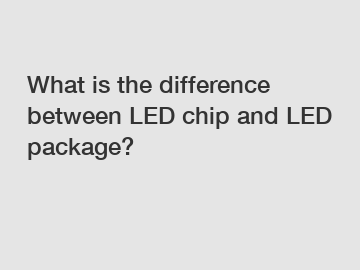Feb. 12, 2024
Lights & Lighting
Getian contains other products and information you need, so please check it out.
What is the difference between LED chip and LED package?
As technology continues to evolve, so do our lighting options. LED lighting has become increasingly popular due to its energy efficiency and long lifespan. However, when it comes to LED technology, there can be confusion regarding the difference between an LED chip and an LED package. In this article, we will explore the dissimilarities between these two components and shed light on their respective roles in LED lighting systems.

1. Definition and Functionality:
An LED chip is the core component of an LED. It is a small semiconductor device that emits light when an electrical current passes through it. The chip is typically mounted on a substrate, such as a ceramic or metal plate, to provide mechanical support and heat dissipation. On the other hand, an LED package refers to the assembly that houses the LED chip, providing protection, electrical connections, and heat management.
2. Size and Shape:
LED chips are extremely tiny, usually measuring less than a square millimeter. Their compact size allows for high-density integration and enables manufacturers to create diverse lighting designs. The shape of an LED chip often determines the directionality of light emission. For instance, a square-shaped chip emits light in a wider beam angle compared to a circular chip.
LED packages, on the other hand, come in a variety of shapes and sizes. They are designed to provide a convenient platform for the installation of LED chips. Common package types include Surface Mount Devices (SMD), Chip-on-Board (COB), and Dual In-line Package (DIP). Different packages offer different advantages, such as better heat dissipation or ease of mounting.
3. Construction and Components:
LED chips primarily consist of three main layers: an n-type semiconductor layer, an active layer, and a p-type semiconductor layer. The active layer, made of gallium nitride (GaN) or another similar material, produces light when an electric field is applied across it. Furthermore, chip construction can vary depending on the desired color output, as different materials are used for different colors (e.g., indium gallium nitride for blue LEDs).
LED packages, on the other hand, are more complex in construction. They typically comprise a package body, lead frames, lens, and encapsulant. The lead frames provide electrical contact points for the chip, while the lens focuses and shapes the emitted light. Additional components such as heat sinks and phosphor layers may also be present in certain types of packages to enhance heat dissipation and color conversion.
4. Optical and Electrical Characteristics:
LED chips produce light directly from the active layer, showcasing high efficiency and brightness. Their small size allows for precise control over the directionality and uniformity of light output. The optical characteristics of a chip play a crucial role in determining the overall lighting performance.
LED packages, however, are not only responsible for protecting the LED chip but also play a significant role in enhancing the optical characteristics. The package design, lens, and encapsulant influence factors such as light distribution, color rendering, and efficiency. Therefore, selecting the right LED package is essential in achieving the desired lighting outcome for a specific application.
In conclusion, while LED chips and LED packages are both integral components of LED lighting systems, they serve distinctive purposes. The LED chip is the fundamental source of light emission, while the LED package provides structural support, electrical connections, and optical enhancements. Understanding the differences between these two components is crucial in selecting the appropriate LED technology for diverse lighting applications.
If you are looking for more details, kindly visit our website.
Contact us to discuss your requirements of cob led modul. Our experienced sales team can help you identify the options that best suit your needs.
If you are interested in sending in a Guest Blogger Submission,welcome to write for us!
All Comments ( 0 )